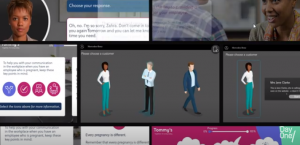Here we look at how to maximise training ROI by leveraging a range of elearning capabilities and benefits.

There are many reasons for organisations to look closely at their training spend, such as the prospect of a recession, rising costs or growing competition. Managers across all functions are continually asked to do more with less, and L&D is no different.
Furthermore, apart from essential onboarding and compliance training, staff development is often seen as a nice to have – something that will drive business performance improvements later, but perhaps less fundamental to the survival of a company than say, Sales or Logistics.
If your L&D budget is under pressure, here are some ways to really leverage the power of elearning in delivering new efficiencies.
Leverage Branching Scenarios
A common myth about elearning used at scale is that it delivers one size fits all training that will only get you so far, and that role-specific learning needs to happen via an instructor and / or on the job.
With elearning branching scenarios, you can start off with training relevant to everyone if you wish, but, much like a Choose Your Own Adventure book, the learner can then branch off onto a learning stream relevant to their role or their existing knowledge level.
As an extension of the starting content, branching scenarios do not tend to add anywhere near the cost of say, a fresh elearning project or getting a trainer in for instructor-led training courses.
The content will be available for future learners as well as the current cohort, so the training ROI will increase over time.
Leverage Simulations
When onboarding new employees or introducing new software, you don’t necessarily want your staff let loose on a new system in the live working environment.
You might also want customer-facing sales or support staff to hone their skills through Learning By Doing in a safe space, with the chance to roleplay a range of scenarios.
System simulations done well can give your employees the chance to practise their technical skills with new software and / or deal with lifelike customer service situations. Such situations have typically been practised with a buddying system, which is of course – people intensive.
With simulation-based training, learners can practise scenarios without a colleague or trainer sat with them throughout, reducing face to face training costs. This also becomes a far easier and cost effective way to train a distributed staff working from home or across multiple locations.
Supervisors / trainers / managers can simply monitor employee practice performance and check in with them periodically or as needed, rather than having to be there in person throughout all the training.
Leverage Learner Analytics
Training mistakes can be costly – not just in terms of the potential human error, but in the potential for wasted training that later proves to have been ineffective in delivering skilled employees.
By leveraging the data capture and reporting capabilities of a learning management system (LMS), L&D managers can laser in on learners who need additional support in specific areas, or on course content that people are finding tricky or less engaging.
Face to face training is often delivered with the assumption that if you turned up, you learned it. Yet the classroom environment is often extremely distracting (just like at school) and not the most conducive to knowledge retention and skills development for all types of learner.
Identify high-fliers and support those who need more guidance by seeing useful data and actionable insights within your elearning platform.
Can We Help You?
For over two decades we’ve created interactive, high-impact elearning that doesn’t break the bank, making us the sweet-spot training solutions provider for some of the world’s best-known brands.
Would you like to speak to one of our elearning strategy experts about leveraging technology to find new efficiencies and maximise your training ROI?
Contact us here at Day One.


















